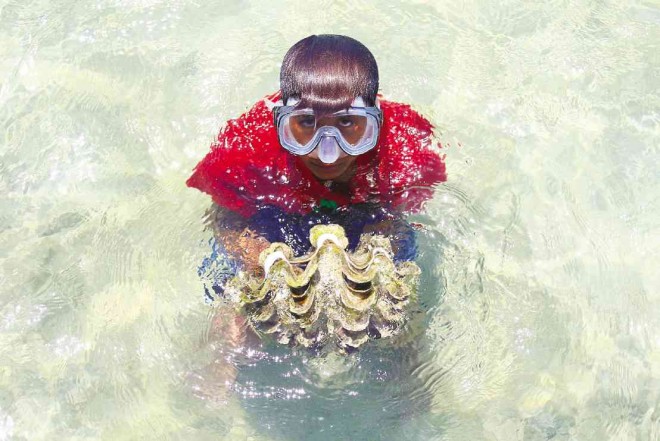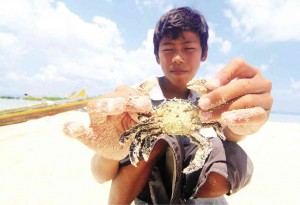Masbate blast fishermen now ‘reef rangers’

A BOY shows a live giant clam (Tridacna gigas) near the shoreline of Buntod Island in Masbate City. PHOTOS BY MARK ALVIC ESPLANA
Turning their backs on their wrongdoing that almost destroyed the marine ecosystem around them, members of the Samahan ng Mangingisda ng Puro-Sinalikway (Samapusi) are now protectors of the Buntod Reef Marine Sanctuary and the Pawa Mangrove Ecosystem and Wildlife Park, the two marine gems of Masbate City.
Since 2001, Samapusi, composed of erstwhile dynamite fishers, has been involved in taking care of and acting as tour guides at the vast marine sanctuary and mangrove forests, according to its president, Romeo Soria Jr.
Soria, 38, said the members started to rehabilitate the sanctuary they once almost drove to destruction after they were educated by then Mayor Socrates Tuason and personnel from the City Environment and Natural Resources Office (Cenro) of the damage that dynamite fishing inflicted upon the environment.
Through weekly seminars and forums, they came to realize how important Buntod’s reef and mangroves are to them, he said.
Before they became deeply involved with the government in efforts to conserve wildlife, the city government provided them with livelihood assistance in the form of motorized boats, fishnets, hook-and-line gear and other fishing facilities, Soria said. They gave up explosives in exchange, he added.
Article continues after this advertisementWhen they were not on duty as tour/reef guides, they spend their time fishing outside the 234.54-hectare sanctuary or transplanting corals and conserving seagrass to further enrich the marine ecosystem of Buntod Reef.
Article continues after this advertisement
Sea cucumbers
They engage in “sea ranching,” which involves the propagation of sea cucumbers they buy from other fishermen in the 51.54-ha core zone of the sanctuary in order to add life and color into the scuba diving and snorkeling experiences of tourists.
“We put the sea cucumbers inside small cages in the coral reefs until they are old enough to be released,” Soria said. “We transplant corals from the waters outside the marine sanctuary into the reefs in order to increase the population of corals. We conserve seagrass from places where it is exposed to erosion by transferring them to more stable areas.”
Members of Samapusi also clean up the mangrove forests in Buntod and Pawa every day in order to further care for some 200 propagules they planted there, he said.
Aside from repopulating the reef, Samapusi engaged four months ago in abalone culture to provide another source of income to its 33 members and their families. Abalone is a marine gastropod mollusk or very large edible sea snails which are used in Chinese cuisines and are valued at P200 to P380 per kilo.
Tourists’ safety
Chandyllane Cantre, ecotourism enterprise development assistant of Masbate Cenro’s Integrated Coastal Resources Management Project, said the fishermen underwent training for them to become “reef rangers.”
Samapusi members are also trained in Water Search and Rescue (Wasar) to provide safety for tourists, she said.
Joseph Belda, a Samapusi member, was able to use his Wasar skills when he rescued June Paolo Abrazado, the aide of the late Interior Secretary Jesse Robredo, who was the lone surivor when the light aircraft carrying Robredo and three others met its doom at Masbate Bay in August 2012.
Aside from repopulating the marine sanctuary, Samapusi is tasked with protecting it from illegal fishers.
The group was deputized by the city government and given the power to perform arrests with the help of Bantay Dagat and the Philippine Maritime Authority.
Rizaldo Radaza, 48, a Samapusi member, said that becoming a part of the reef rangers of Buntod brought the community extra income.
With his job as reef guide to tourists, Radaza has upped his P300 income from fishing a day to around P1,100.
Recognition
Due to Samapusi’s efforts, Cantre said the Buntod Reef Marine Sanctuary was named the second most resilient marine reserve site to climate change in central Philippines in an assessment conducted by Silliman University professors.
The Bungsayon Marine Reserve, which is along the Masbate Pass, got the first slot as the most resilient marine reserve to climate change, according to the assessment conducted in 2011.
Samapusi was also named one of the seven Inang Kalikasan Award recipients in 2013 by the Department of Environment and Natural Resources, Cantre said.
The efforts in the Buntod Reef Marine Sanctuary became a factor in Masbate City’s triumph in the Galing Pook Awards given by Galing Pook Foundation in 2012, she added.
